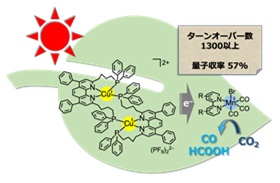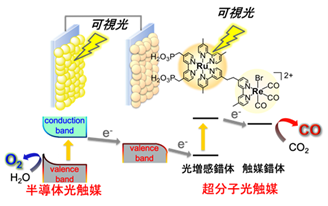Contact
Ookayama 2-12-1-NE-1,
Meguro-ku, Tokyo
152-8550, Japan
Room 701 (Prof.),
Room 702
(Associate Prof.),
Room 703 (Assistant Prof., Students)
(access)
TEL: +81-3-5734-
2240 (Room 701)
2239 (Room 702)
2759 (Room 703)
e-mail: ishitani@chem.,
maedak@chem.
(+titech.ac.jp)
Our Goal
Our goal is to create new chemical concepts that contribute to the effective use of light energy. It is said that the 21st century is the "age of light," but photochemistry and photofunctional chemistry, which form the basis of this age, have not yet been fully developed.
For example, the effective use of light energy could be an ideal solution to the serious problems that humanity will face in the future, such as global warming caused by rising atmospheric carbon dioxide concentrations and the energy crisis caused by the depletion of fossil fuels. Unfortunately, however, chemical methods of utilizing sunlight falling on the earth through artificial methods are still at a rudimentary stage.
In addition, functional devices at the molecular level must be driven by photons instead of electrons, but chemical knowledge of photofunctional expression is still extremely lacking. Satisfactory materials have not yet been obtained for semiconductor photocatalysts in powder form, and academic knowledge is not yet sufficient.
We are therefore taking on the challenge of solving these problems from an experimental chemistry standpoint. Specific examples are shown below.
① As a basic research for the conversion of solar energy into chemical energy, we aim to create new photocatalysts, mainly metal complexes.
② Construction of an artificial system with functions similar to plant photosynthesis (artificial photosynthesis)
③ Establishment of molecular design guidelines and synthesis methods for complex supramolecules (e.g. molecular wires) that can control light and electron transfer
④ Hybridization of metal complex photocatalysts and solid materials for highly functional CO2 reduction reaction
⑤ Development of CO2 reduction system using water as reducing agent
⑥ Direct reduction of low-concentration CO2 to resources
Furthermore, through these studies,
⑦ Adding new knowledge to the still poorly understood field of "photoreaction chemistry of organometallic complexes
This is also an important objective. We are only trying to establish new compound groups, methodologies, and concepts that have not been reported before.
We are also committed to collaborative research with researchers in Japan and abroad. In Japan, we have conducted student exchanges and collaborative research with Kyushu University, Kyoto University, Tokyo University of Science, Hokkaido University, Hiroshima University, Nagoya University, Rikkyo University, and RIKEN. We have also conducted joint research with universities in France (University of Paris, Sorbonne, CER Grenoble), England (University of Strathclyde), and Italy (University of Messina, University of Bologna), and have received students and staff from these universities in our laboratories, and our students and staff have stayed in their laboratories to conduct experiments. We have achieved many results.


Fig. Photocatalytic activity of supramolecular metal complex
In the course of these studies, we always intend to construct unrevealed compounds, methodology, and concepts. If you are interested in our research, please see more details at Research and contact us;
Prof. Osamu ISHITANI
Ookayama 2-12-1-E1-9, Meguro-ku, Tokyo 152-8550, Japan Department of Chemistry, School of science, Tokyo Institute of Technology TEL: +81-3-5734-2240 e-mail:ishitani@chem. (+ "titech.ac.jp")


